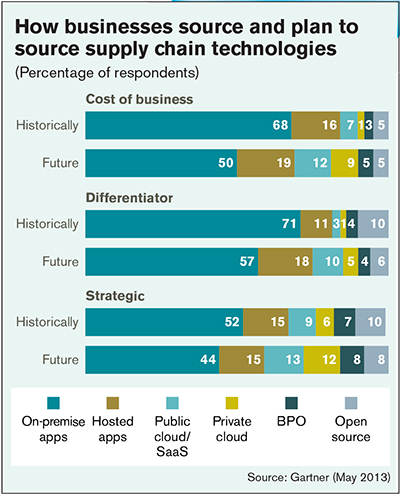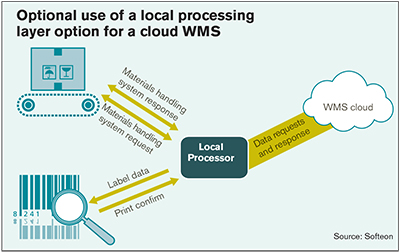Supply Chain & Logistics Technology: The state of cloud solutions in the warehouse
WMS lags behind other categories in cloud adoption, but is poised for growth as solutions scale up to meet the needs of larger sites.
Latest Logistics News
Supply Chain Stability Index sees ‘Tremendous Improvement’ in 2023 Descartes March Global Shipping Report highlights ongoing steady volume momentum U.S.-bound import growth track remains promising, notes Port Tracker report EU Update 2024: Crises lead to growth Examining the impact of the Taiwan earthquake on global supply chain operations More Global TradeFor all of the hype about cloud computing in recent years, when it comes to the cloud for deploying supply chain execution (SCE) software such as warehouse management system (WMS) solutions, the numbers tell a pretty modest story. While some other enterprise software categories such as customer relationship management (CRM) have seen cloud solutions catch on in a significant way, the SCE segment lags behind. For instance, cloud-based WMS sales in 2013 only accounted for about 8 percent of the WMS market, according to Chad Eschinger, an analyst with Gartner Research.
By comparison, Gartner estimates that 45 percent of the CRM market was cloud-based in 2013, while the overall supply chain management software market was 21 percent cloud in 2013.
“Cloud adoption for warehouse management is pretty nascent today,” says Eschinger. “We haven’t seen a huge onslaught of activity. There are some vendors winning deals out there, but I would call many of these less sophisticated warehouse environments.”
ARC Advisory Group, another analyst firm, also pegs the cloud share of the WMS market at less than 10 percent, though it sees more externally focused logistics solutions such as global trade management (GTM) at much higher cloud penetration.
Why are some cloud-based SCE solutions, particularly WMS, not catching on strongly? There are multiple theories as to why, led by the notion that users aren’t quite ready to trust the cloud for a transaction-heavy, more internally oriented systems, which are critical to tactical execution.
For instance, notes Eschinger, the enterprise resource planning (ERP) market also has relatively low cloud sales, and the categories with higher rates tend to be areas like CRM or human capital management.

Other hurdles for cloud-based WMS include the perception that cloud solutions can’t handle large sites, or that in far-flung regions cloud reliability becomes a factor. But suppliers of cloud-based SCE solutions say the realities of the market are changing. Cloud WMS, some suppliers contend, is scaling up to handle bigger, more complex environments, including integration with automated materials handling systems.
“One myth out there is that cloud WMS does not offer rich, Tier 1 functionality—that the solutions are less mature than on-premise solutions,” says Larry Ferrere, chief marketing officer for LogFire, a cloud-based vendor of SCE solutions including WMS. “While it’s fair to say that cloud solutions generally tend to be less mature than on-premise ones because the cloud segment is much newer, that doesn’t mean that a particular cloud solution cannot be functionally rich.”
The proof points, says Ferrere, come from LogFire’s customer base, where users such as Supermercados Peruanos, a large grocery chain in South America, has 350 users of the LogFire Cloud WMS at its main distribution center. That site also has automated equipment such as conveyors and sortation systems integrated with the WMS.
For end-user organizations, cloud solutions promise lower upfront costs because there are no servers to install in-house, and also because the software is paid for on a subscription-based “software as a service” (SaaS) model. To assess the state of cloud SCE, users need to know about approaches to cloud architecture, and must judge for themselves whether a solution has the depth and flexibility to meet evolving needs.
Why architecture matters
Most cloud solutions are offered under a SaaS model, and many, but not all, feature a “multi-tenant” architecture. Multi-tenant means that all user companies tap the same code base for the core functionality, with a separate layer of software to handle customizations such as workflows, alerts, reports, forms, and labels. The users of a multi-tenant system can’t change the core software, but that doesn’t mean they can’t adapt the system, explains Ranga Bodla, senior director of industry marketing for manufacturing and distribution at cloud-based vendor NetSuite.
“We allow you to customize,” says Bodla. “The changes can be as simple as look and feel, or more complex, like adding tables, adding fields or entire application workflows. All of these changes, when we do an upgrade, will seamlessly migrate to the new version.”
A multi-tenant architecture, says Bodla, avoids a common pitfall of internally run software: modifications to core code that get users and vendors alike bogged down in release migration work. “From a research and development perspective, we’re able to focus all of our attention on the innovation for the next version of the software, as opposed to band-aiding multiple older versions,” says Bodla.
NetSuite’s customization platform was tapped by eBizNET Solutions to create a suite of cloud-based SCE applications, including a WMS, aimed at small to mid-market companies.

“I think it’s a misconception to believe that a multi-tenant cloud system can’t be customized to meet specific business processes,” says Sitaram Geddam, eBizNet’s founder and CEO. “That may have been true a few years back, but I think we’ve come a long way since then. Just the fact that eBizNet can build an entire WMS using the tools from NetSuite—the same tools available to all their customers—speaks to the adaptability issue.”
Typically, adds Geddam, users of eBizNet’s WMS want to customize reports, forms like packing lists, as well as shipping or other labels. The customization layer from NetSuite also gives users the flexibility to create alerts, workflows or change the look of screens. For example, a user company can add an expiration alert to a batch of goods.
For Epicuren, a user of NetSuite’s cloud ERP solution and eBizNet’s WMS, a key benefit was speedy implementation. Epicuren, a Laguna Hills, Calif.-based manufacturer and distributor of skin care products, was able to implement the joint solution in just four months, going live in January 2012, according to Brian Douglas, project manager for Epicuren.
The WMS functionality met Epicuren’s need to have tight control over lot- and expiration-date sensitive materials and order planning processes, says Douglas, while the cloud model supported rapid implementation.
Fit and function
Some cloud solutions are aimed primarily at small- to mid-sized companies, or relatively smaller sites of large companies. Most of eBizNet’s WMS users, says Geddam, have five to 50 users, and transaction volume is less than 20,000 order lines per day.
LogFire, however, positions its cloud WMS as capable of handling large sites. According to Ferrere, this means the solution not only needs to handle larger user counts and volumes, but also have multi-site and “multi-entity” capabilities.
Additionally, says Ferrere, a Tier 1 WMS today also should support multi-channel fulfillment, meaning the system needs to be just as adept at managing items as it does cases, while also being able to stage goods for parcel shipments. The trouble in meeting the multi-fulfillment challenge with WMS, says Ferrere, is that in many cases, on-premise solutions that were heavily customized have become so bogged down by release migration issues that the user companies can’t get onto newer software geared for multi-channel needs.
According to Diego Pantoja-Navajas, LogFire’s founder and CEO, LogFire’s WMS was conceived “from the ground up” to be a Tier 1 level solution capable of handling larger, complex operations. One user site, he says, is processing about 400,000 order lines per day. “These are large facilities with fast moving items,” he says.
Deploying a cloud WMS for a larger site still takes plenty of planning in terms of how to best configure the solution to meet desired procedures, and proper testing of integration to automated systems. In other words, there is no shortcut to business requirements planning and integration steps, notes Pantoja-Navajas. But with cloud WMS, he adds, it’s simple for the vendor to allocate more capacity if the user company expects a stretch of heavy volume during peak seasons, or for other rapid changes.
Cloud reliability issues
Satish Kumar, a vice president with Softeon, which offers a cloud-based WMS, agrees that it is easy for a cloud solution to scale up to accommodate more users or higher peak volumes. “We host on Amazon [Amazon’s cloud infrastructure], so it’s elastic—we can expand the capacity as much as needed in just a few minutes,” Kumar says.
But this potential strong suit of the cloud—the ease of tapping large server farms run by someone else—also carries a potential downside in that if you lose your cloud connection, you’re solution access goes down. Clint Reiser, a research analyst with ARC, says the reliability of cloud connections is an issue that potential users should examine carefully, especially in emerging markets where telecommunications may be unreliable.
Cloud vendors, however, say having a back-up cloud connection for each site can mitigate cloud connectivity concerns. Users also typically need backup power protection for the site’s network gear. Such reliability measures, however, are already normal practices for industrial sites in emerging markets, says Geddam. “It’s easier and cheaper today to have redundant cloud connectivity than to try to have redundant systems and data center infrastructure at every single site,” he says.
Kumar agrees that performance concerns can be dealt with easily. In Softeon’s case, it offers the option of a local server running a software agent to handle time-sensitive WMS interactions such as label printing or communications with automated materials handling systems.
To date, the SCE solutions that have done best at the cloud are categories such as transportation management and GTM that are naturally more network-centric. But as more vendors come forward with cloud solutions with more functional depth, flexibility and ability to handle large sites, WMS in the cloud is poised to grow.
“Who would have thought a few years ago we would see companies moving office software to the cloud, but now it’s commonplace,” says Kumar. “Similarly, supply chain apps will move into the cloud because of the reduced capital costs, the extensibility, and the speed of how quickly the solutions can be deployed.”

Article Topics
Global Trade News & Resources
Supply Chain Stability Index sees ‘Tremendous Improvement’ in 2023 Descartes March Global Shipping Report highlights ongoing steady volume momentum U.S.-bound import growth track remains promising, notes Port Tracker report EU Update 2024: Crises lead to growth Examining the impact of the Taiwan earthquake on global supply chain operations Descartes announces acquisition of OCR Services Inc. Industry experts examine the impact of Baltimore bridge collapse on supply chains More Global TradeLatest in Logistics
LM Podcast Series: Assessing the freight transportation and logistics markets with Tom Nightingale, AFS Logistics Investor expectations continue to influence supply chain decision-making The Next Big Steps in Supply Chain Digitalization Warehouse/DC Automation & Technology: Time to gain a competitive advantage The Ultimate WMS Checklist: Find the Perfect Fit Under-21 driver pilot program a bust with fleets as FMCSA seeks changes Diesel back over $4 a gallon; Mideast tensions, other worries cited More LogisticsSubscribe to Logistics Management Magazine

Find out what the world's most innovative companies are doing to improve productivity in their plants and distribution centers.
Start your FREE subscription today.
April 2023 Logistics Management

Latest Resources















